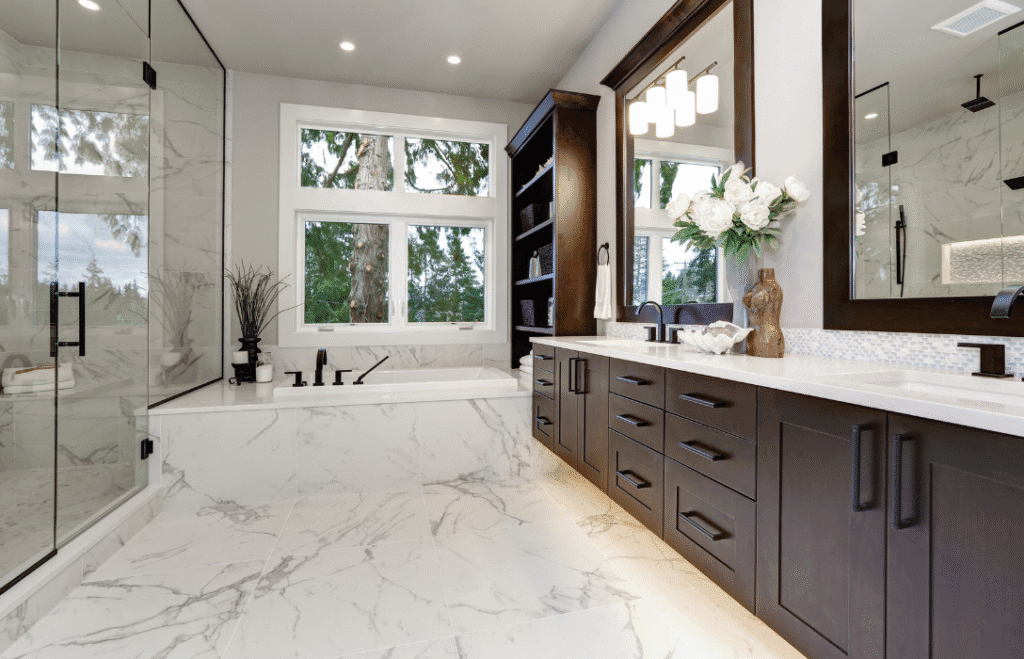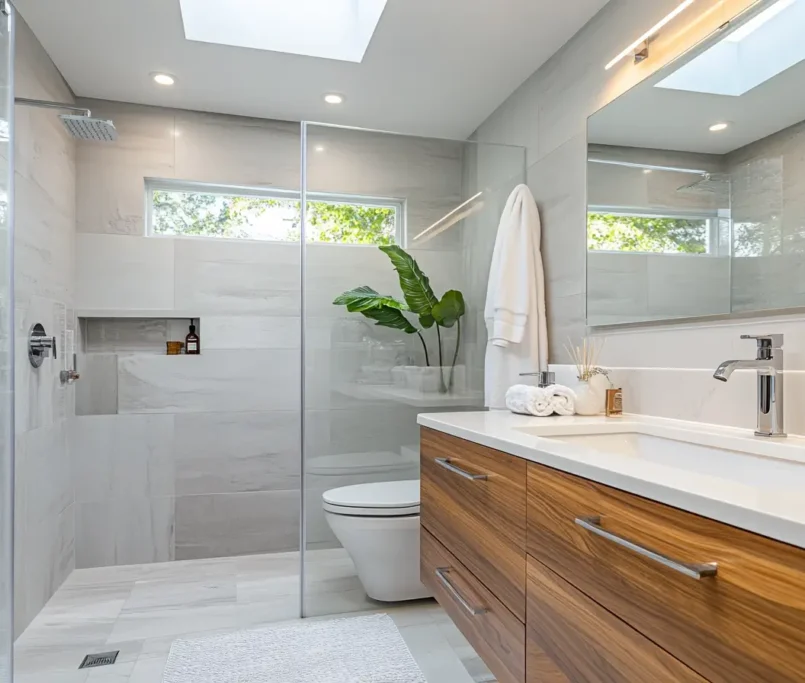Bathroom Lighting & Ventilation: Tips for Better Design & Functionality
Why Proper Lighting and Ventilation Are Key to a Perfect Bathroom
Your bathroom is more than just a space to shower and brush your teeth—it’s a place of relaxation and refreshment. But achieving that perfect bathroom experience requires more than just a stylish sink or a beautiful bathtub. Proper lighting and ventilation are essential elements that contribute to the comfort, health, and functionality of your bathroom. Unfortunately, many homeowners overlook these factors, which can lead to problems like poor air quality, excess humidity, and a dim, uninviting atmosphere.
Good lighting does more than just illuminate the space—it creates the right mood, highlights your bathroom’s design, and ensures tasks like shaving, applying makeup, and reading are easier. On the other hand, proper ventilation plays a critical role in controlling humidity levels, preventing mold growth, and improving air quality. Without it, your bathroom could quickly become a breeding ground for moisture-related issues.
In this blog, we’ll explore how lighting and ventilation work together to enhance your bathroom. We’ll provide expert insights on how to choose the best lighting for your space, tackle common bathroom lighting issues, and explain how to improve ventilation to create a healthier, more comfortable environment. Whether you’re renovating your bathroom or just looking to optimize the space, proper lighting and ventilation are the keys to achieving both functionality and style.
How Lighting and Ventilation Work Together for Bathroom Health
Lighting and ventilation go hand in hand when it comes to maintaining a bathroom’s overall health and comfort. Proper lighting enhances visibility and mood, while efficient ventilation prevents excess moisture and air stagnation. Together, they ensure your bathroom remains a comfortable, healthy, and inviting space. With the right lighting and ventilation, you can reduce mold growth, improve air quality, and enhance the overall ambiance of your bathroom.
In the following sections, we’ll take a closer look at both factors and discuss how to balance these elements for the best bathroom experience.
The Role of Lighting in Creating the Right Bathroom Atmosphere
Lighting plays a huge role in shaping the ambiance of your bathroom. A well-lit bathroom not only makes daily tasks easier but also creates a more inviting space. There are three main types of lighting to consider for your bathroom:
- Task Lighting
Task lighting is focused lighting that provides adequate illumination for specific tasks like shaving, grooming, or applying makeup. The ideal task lighting is bright and direct, often provided by sconces or vanity lights placed around the mirror. - Ambient Lighting
Ambient lighting is general lighting that provides overall illumination for the entire bathroom. This can be achieved using overhead lights, ceiling-mounted fixtures, or even LED downlights. Ambient lighting should be soft and evenly distributed to avoid harsh shadows or glaring light. - Accent Lighting
Accent lighting is used to highlight certain features or elements of the bathroom, like a beautiful tile pattern or decorative artwork. This type of lighting adds depth and style to the space and can be achieved using LED strips, pendant lights, or small spotlights.
When designing your bathroom lighting, it’s important to consider the size of your space, the layout, and your specific needs. If you have a small bathroom, using a combination of all three types of lighting will help maximize both functionality and aesthetics.
Common Bathroom Lighting Issues and Solutions
Poor lighting can make your bathroom feel cramped, dark, and unwelcoming. Here are some common issues homeowners face and how to solve them:
- Too Dim or Overly Bright Lights
If your bathroom feels too dim or is overwhelmingly bright, consider adjusting the wattage of your bulbs. Install dimmable light fixtures to give you the flexibility to control the brightness based on the time of day or the task at hand. - Energy Inefficiency
If your bathroom lighting isn’t energy-efficient, it could be driving up your electricity bills. Replace incandescent bulbs with LED lighting, which uses less energy and lasts much longer. This simple switch can save you money while providing superior lighting quality. - Harsh Shadows
Shadows around your face or body can make grooming tasks difficult. Avoid overhead lights that create harsh shadows by adding task lighting around the mirror or vanity. A combination of sconces or LED strips will provide even lighting, eliminating those pesky shadows.
By addressing these common issues, you can transform your bathroom into a well-lit, functional space.
Bathroom Ventilation: Why It’s Just as Important as Lighting
While good lighting is essential for visibility, ventilation is equally important for the health and longevity of your bathroom. Bathrooms are constantly exposed to moisture, whether it’s from showers, baths, or sinks. Without proper ventilation, excess humidity can lead to a host of problems, including:
- Mold and Mildew Growth
Moisture buildup can promote mold and mildew, which thrive in warm, damp environments. Mold not only ruins your bathroom’s appearance but can also cause health issues, especially for individuals with allergies or asthma. - Water Damage
Consistent moisture exposure without ventilation can lead to water damage on walls, floors, and ceilings. This could result in rotting wood, peeling paint, and rusted fixtures. - Poor Air Quality
Without ventilation, your bathroom can quickly become stuffy and filled with unpleasant odors. Proper air circulation is vital for maintaining a healthy environment.
Types of Bathroom Ventilation Systems
- Exhaust Fans
Exhaust fans are a must-have in every bathroom to expel humid air and maintain air quality. A good exhaust fan should be energy-efficient, quiet, and appropriately sized for your bathroom. Fans with timers or humidity sensors are particularly helpful, as they automatically turn on when needed. - Ceiling Vents
Ceiling vents work similarly to exhaust fans by expelling moisture-laden air out of the bathroom. These vents are often more efficient in larger bathrooms or those with multiple moisture-producing fixtures. - Window Ventilation
If you have a window in your bathroom, open it after showers to allow fresh air in. This natural ventilation method is free and effective, especially when combined with an exhaust fan.

Real-Life Problems: Ventilation Challenges in Bathrooms
Homeowners frequently encounter ventilation issues that lead to dampness, mold, and poor air quality. Common problems include:
- Inadequate Fan Size
If your bathroom fan is too small, it won’t be able to remove enough moisture. Choosing the right fan size based on the square footage of your bathroom is essential for effective ventilation. - Clogged Vents
Over time, bathroom vents can become clogged with dust, lint, or even debris from a leaky roof. Regular maintenance is key to keeping your ventilation system working efficiently. - Improper Installation
Sometimes, ventilation systems are installed incorrectly, leading to inadequate airflow or water damage. It’s crucial to ensure your exhaust fan is installed according to manufacturer instructions for optimal performance.
Choosing the Right Exhaust Fan for Your Bathroom
Choosing the right exhaust fan is essential for effective ventilation. Consider the following factors when selecting a fan:
- Room Size: Fans are rated based on their ability to move air, typically measured in CFM (Cubic Feet per Minute). A fan should be able to expel at least one CFM for every square foot of bathroom space.
- Moisture Levels: For bathrooms with high moisture levels, such as those with a shower or bathtub, opt for a high-performance fan with additional features like humidity sensors.
- Noise Level: If noise is a concern, choose a fan that operates quietly (below 1.5 sones is considered very quiet).
Energy-Efficient Lighting and Ventilation Solutions
Both lighting and ventilation can be energy-intensive if not managed correctly. Here are some ways to make your bathroom more energy-efficient:
- Switch to LED Bulbs: LEDs use significantly less energy than incandescent bulbs and have a much longer lifespan.
- Install a Humidity-Sensing Exhaust Fan: These fans turn on when humidity levels reach a certain point, ensuring efficient moisture removal without running constantly.
- Utilize Natural Light: Take advantage of natural light during the day to reduce reliance on artificial lighting.
By adopting energy-efficient solutions, you can reduce your bathroom’s environmental impact and save money on utility bills.
Transform Your Bathroom with Better Lighting and Ventilation
Proper lighting and ventilation are essential components of a functional and comfortable bathroom. By choosing the right lighting and ventilation systems, you can create a brighter, more inviting atmosphere while preventing moisture-related issues. Whether you need to install a new exhaust fan, upgrade your lighting, or seek professional advice on optimizing your bathroom’s airflow, Grand Building Construction is here to help.
Ready to upgrade your bathroom lighting and ventilation? Contact Grand Building Construction for expert remodeling solutions!
FAQs
Q1: What is the best lighting for a small bathroom?
For small bathrooms, use bright LED lighting fixtures that distribute light evenly. Consider adding a combination of task, ambient, and accent lighting to create a balanced atmosphere.
Q2: How can I improve bathroom ventilation without installing a fan?
Opening windows, using dehumidifiers, and applying moisture-resistant materials can help improve bathroom ventilation without an exhaust fan. However, installing a fan is the most effective solution.
Q3: Are there any energy-efficient lighting options for bathrooms?
Yes! LED lights are the most energy-efficient option. Consider using dimmable LED lights to adjust the brightness based on your needs.




